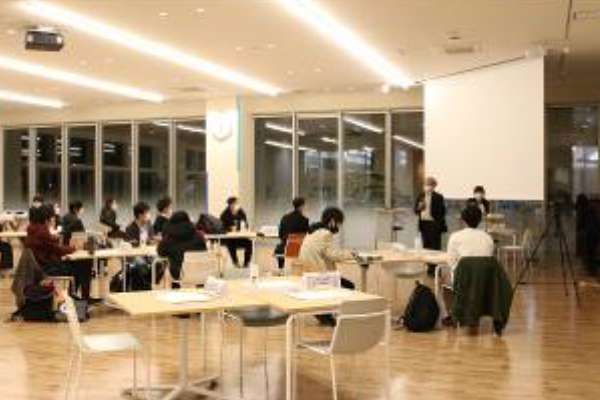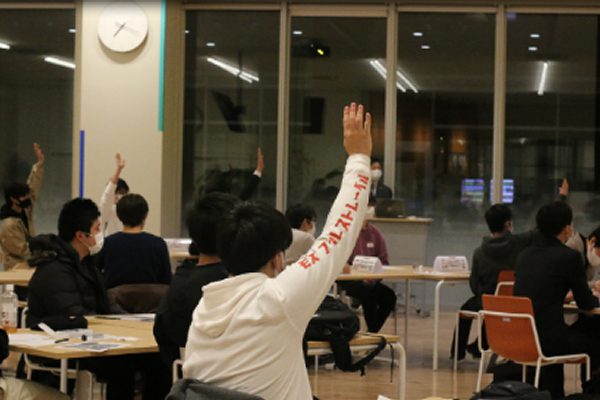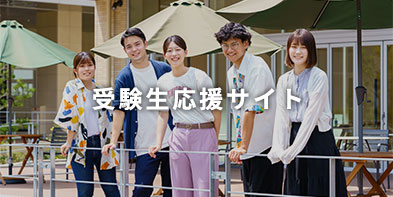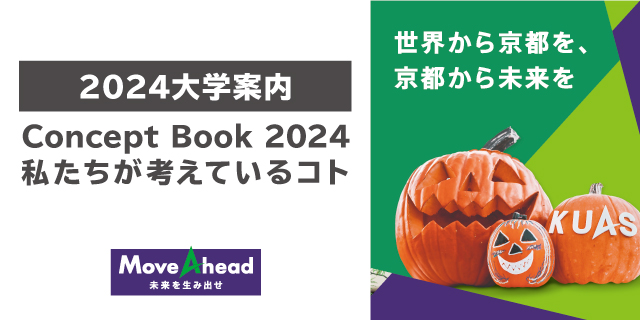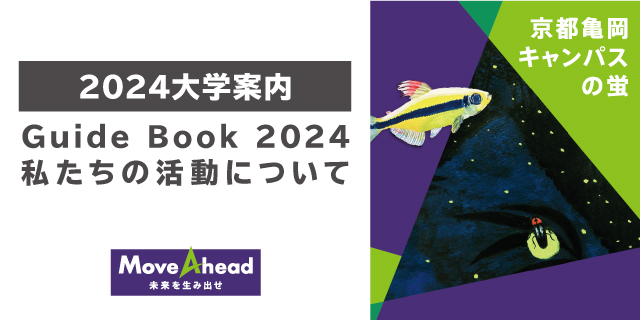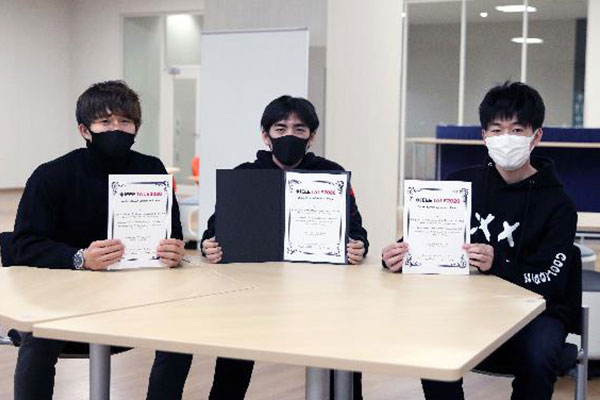
2020年12月、「革新的なテクノロジーによる学習の新時代への参入」をテーマに開催されたInstitute of Electrical and Electronics Engineers (IEEE) TALEのStudent Research Competitionに出場した本学工学部機械電気システム工学科1年の田中大誓さん、又吉信二郎さん、ユンセナさん。パンデミック時に混雑した場所を避け、感染予防につながることを目的に考案した、教室の利用状況をリアルタイムでモニタリングするシステム「AkiKomi」を提案し、出場したUndergraduateのカテゴリーで優勝を果たした3名にお話を伺いました。
提案した内容は、こちらをご覧ください。
※IEEEとは、米国に本部をおく電気・電子・情報工学分野の世界最大規模の専門家組織(学会)、技術標準化機関です。TALEとは、IEEE Education Societyのアジア太平洋地域が主催する工学教育分野で最も影響がある国際会議です。
―このたびは、IEEE TALE Student Research Competition学部カテゴリーの優勝、おめでとうございます。そもそも「Akikomi」は、どういう背景から生まれたのでしょうか。
春学期のモバイルアプリケーションの設計について学ぶ「デザイン基礎(テーマⅢ)」の授業で学んだことを生かして、夏休みに何か自分たちでアプリを作ってみようと思っていたところ、学内の教室の混雑状況が一目で把握できれば、新型コロナウイルス感染症のクラスター発生の抑制にもつながるのではないかと思い立ったのが始まりです。
最初は、田中くんと私の2人で進めていましたが、授業時間だけではアプリの実装まで追いつかず、担当教員の梁先生の勧めでモバイルアプリケーションの設計に詳しいセナくんにも参加してもらいました。
秋学期以降は、3人で授業後に集まって相談しながら少しずつアイデアを練っていきました。
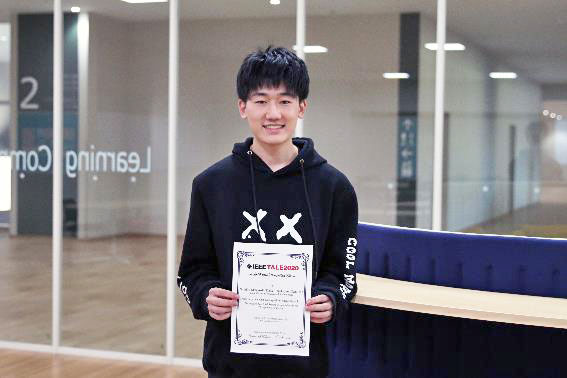
―なるほど。「Akikomi」はどのようなサービスなのか詳しく教えてもらえますか。
「Akikomi」は、教室の混雑状況がいつでもどこでも誰もが簡単にスマートフォンのアプリ上で確認できて、教室の混雑状況が一目でわかるようなサービスになります。工業高校出身の又吉くんはセンサーに詳しくて、いろいろ用意してもらいました。
具体的に言えば、部屋の状況が正確に把握できるように部屋の入り口に温度検知が可能なGrid-EYE センサー、物体検知が可能な空中超音波センサー、被写体同士の距離を検出するTOFセンサー、そして露光制御、ホワイトバランス、輝度検出などの自動制御機能を備えた高精細ビデオカメラ「Raspberry Pi camera」の4つのデバイスを駆使して計測しようと考えています。
そして、各デバイスから上がってくる情報をモバイルアプリケーションで一括受信し、スマートフォンで部屋の混雑具合がわかるといった仕組みになります。まだ、センサーからのデータをアプリが受信することはできませんが、センサーの設置と並行してプログラミングを構築していきたいと思っています。
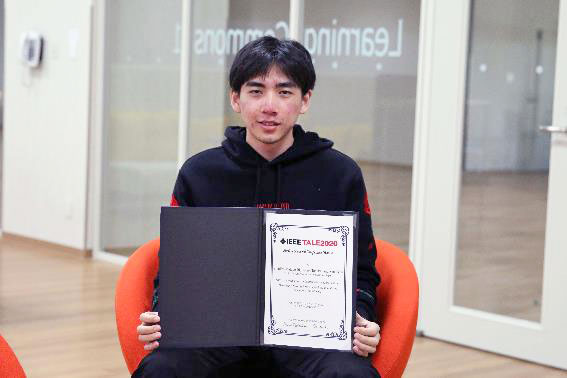
―それぞれの得意分野を生かすなんて、まるでプロジェクトチームですね。その頃からIEEE TALEに出場することを念頭において準備を進めてきたのですか。
いや、本学の教室に実装することを目指して取り組んできましたが、IEEE TALEに出場するつもりはありませんでした。それが、いいアイデアだと梁先生に勧められて実際にIEEE TALEの出場を決めたのは、確か11月頃で、残り1か月ほどしかなく、あわててプレゼン資料を作成し始めました。
特に、この企画が今までにないアイデアで、かつオリジナルであることを証明することは、とても苦労しました。それを調べるため、類似性のある論文をいくつか読み込んで、オリジナリティを見出した時はうれしかったです。
通常、教室の混雑具合を把握する同様のシステムを導入するとなると、大規模な設備機器を用意する必要があるそうですが、その場合、大幅にコストがかかる上、情報へのアクセスも困難でした。しかし、私たちが提案している「AkiKomi」では、軽量IoTセンサーを活用するため、様々なタイプの施設に簡単に導入することができます。また、コストも抑えられ、利用者もスマートフォンアプリで簡単に情報にアクセスできます。ここが、「AkiKomi」のオリジナリティとして、プレゼン資料にまとめていきました。
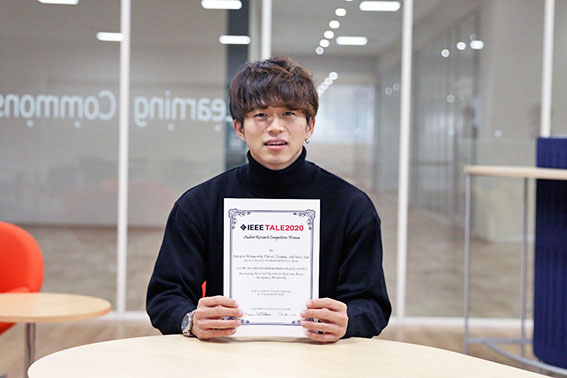
―当日は英語で発表されていたと思いますが、緊張はしなかったですか。
発表自体もいつもスタートアップゼミでは人前に立って英語で発表しているから普段通りの感じでした。
そうそう。いつも英語で授業を受けているから、そこまで英語には抵抗はなかったですね。
確かに。ただ今回のフォーラム自体がオンラインで開催されていて、発表も仮想空間上でアバターを通して行っていたので対面ではない分、まだ緊張せずに発表できたのかもしれませんね。
―ありがとうございました。
(工学部 今井欽之)
[Faculty of Engineering News] An interview with KUAS students who won the IEEE TALE Student Research Competition
In December 2020, KUAS Faculty of Engineering 1st year students Taisei Tanaka, Shinjiro Matayoshi, and Sena Yun participated in the Student Research Competition at the International Conference on Teaching, Assessment and Learning for Engineering (TALE). Organized under the auspices of the Institute of Electrical and Electronics Engineers (IEEE*), the conference adopted the theme of “entering a new era of learning with innovative technology.” The three students proposed a real-time room occupancy monitoring system called “Akikomi” designed to help people find an available empty meeting space and avoid crowded rooms during the ongoing pandemic. We interviewed the three students who won first place in the undergraduate category.
* The IEEE is the world's largest technical professional organization in the fields of electrical, electronic, and information engineering, and technology standardization. TALE is the most influential international conference in the field of engineering education hosted by the IEEE Education Society in the Asia-Pacific region.
― Congratulations on your success in the IEEE TALE Student Research Competition, undergraduate category. What was the initial background to creating “Akikomi”?
It all started when I wanted to make a mobile application during the summer vacation using what I learned in the spring semester class “Introduction to Design” where we studied mobile application design. I thought that it might lead to fewer cluster outbreaks of COVID-19 if it were possible to know how crowded a classroom is at a glance.
At first, Tanaka and I worked on it together, but we could not finish the application using class time alone. At the recommendation of our instructor, Professor Liang, a student named Sena Yun — who is familiar with mobile application design — joined us.
After the fall semester started, the three of us met after class to discuss ideas little by little.
― Could you give some more details about the “Akikomi” service?
“Akikomi” is a smartphone service that makes it easy for anyone to check how crowded classrooms are at a glance, anytime, anywhere. Matayoshi, who graduated from a technical high school, knows a lot about sensors, so he prepared several kinds.
To be specific, I am thinking of making full use of four devices for measurement: a Grid-EYE infrared sensor that can detect the temperature at the entrance of the room so that its condition can be accurately understood, an aerial ultrasonic sensor that can detect objects, a time-of-flight sensor that can detect the distance between subjects, and a high-definition Raspberry Pi video camera equipped with automatic control of functions such as exposure, white balance, and brightness.
The data sent from each device are received simultaneously by the mobile application, and you can see how crowded the room is on your smartphone. The app can't receive data from the sensors yet, but we would like to continue programming in parallel with installing the sensors.
― You really are working as a project team, exploiting each of your competencies. When did you begin preparing for IEEE TALE?
Well, we were working on implementing it in KUAS classrooms but we didn't intend to participate in IEEE TALE. Professor Liang suggested that we join the competition, and we actually decided to participate in IEEE TALE around November. There was only about a month left, so we hurried to make presentation materials.
In particular, it was very difficult to prove that this project was novel. I investigated by reading some related papers and was happy to discover that it was a new idea.
In general you need to prepare large-scale equipment if you want to introduce a system of this kind to monitor how crowded classrooms are. However, our proposed application “Akikomi” uses lightweight IoT sensors and can be installed easily in various types of facility. In addition it is cheap and users can easily access the information with their smartphone. These aspects allowed us to show the originality of “Akikomi” in the presentation materials.
― I think that your presentation was given in English. Weren't you nervous?
The presentation felt normal because we always present in front of people in English in our classes.
I agree. We always take classes in English, so we do not feel resistant to it.
That’s true. However, the forum itself was held online, and we did our presentation in a virtual space using avatars. So we might not have felt nervous because the presentation was given indirectly, not face-to-face.
―Thank you very much.
(Tadayuki Imai, Faculty of Engineering)
- 対象者
- 学部・学科
- 内容

